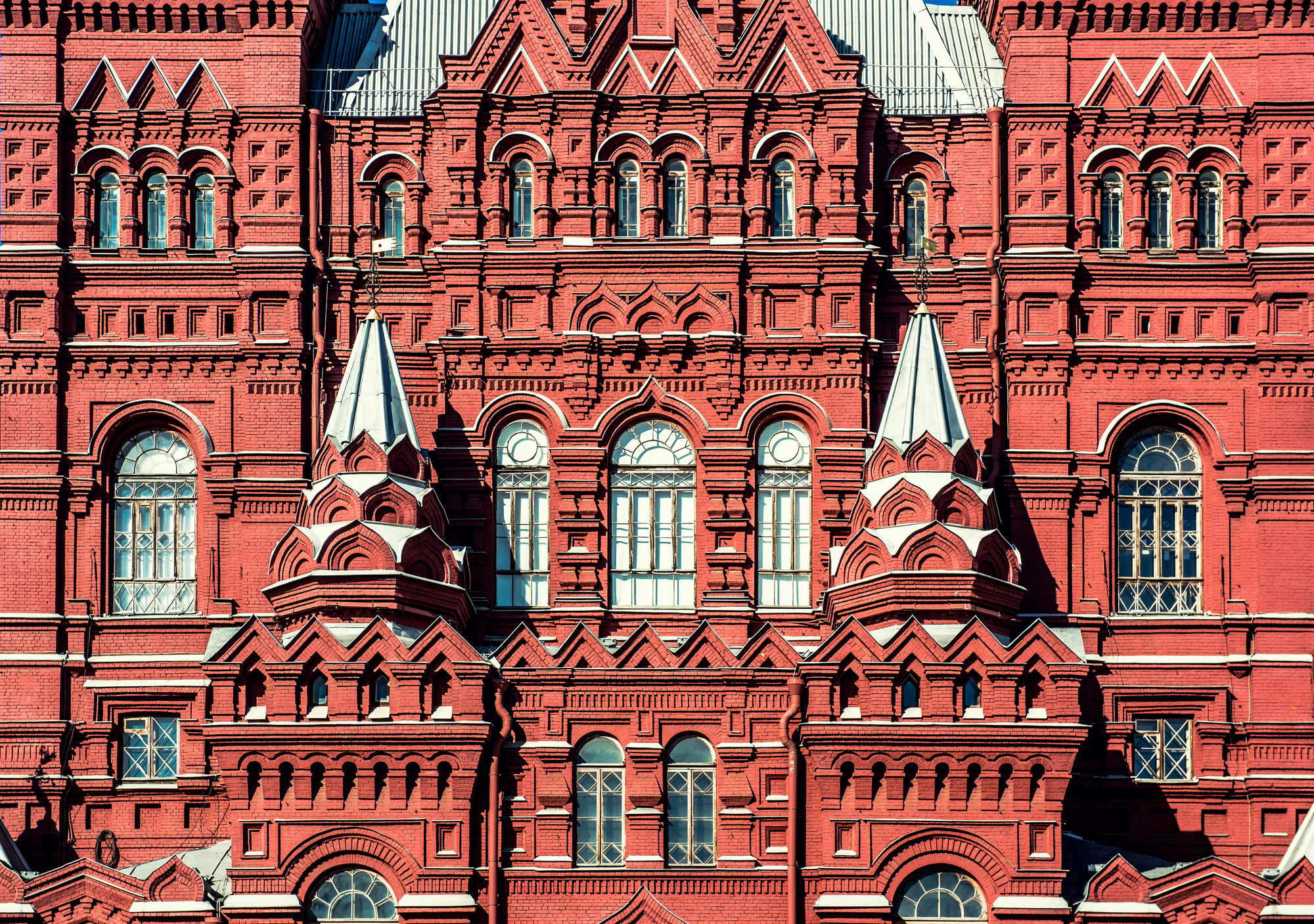Petro Poroshenko’s visit to Washington was, on the whole, positive for his country. The Ukrainian President and his delegation reinforced their relationships with senior U.S. officials and laid the groundwork for some expanded cooperation. The visuals, however, could have been better. It was difficult to avoid the impression that Poroshenko was playing a secondary character in a larger drama. That said, the entire trip demonstrated that the Trump Administration does value Ukraine; the question for Kyiv is whether its value will be that of a piece in someone else’s game or that of an independent actor, delivering real results and real progress.

Poroshenko speaks to Ukrainian-Americans in front of the Holodomor Memorial in Washington, D.C. Source: Twitter.
Poroshenko at the White House
The uncertainty surrounding the Trump-Poroshenko meeting began June 14 when Ukrainian media reported that the two leaders would meet in Washington. Foreign Minister Klimkin confirmed the meeting the following day. However, the White House had only announced that Poroshenko was meeting with Vice President Pence. As late as June 19, the day before the meeting was set to take place, Press Secretary Sean Spicer said only, “if I have any updates on the President’s schedule, I’ll let you know later today.” The White House did not announce that Poroshenko and Trump were meeting until just after 10:00 PM the night before. Taras Berezovets, a Ukrainian political analyst, writes that the meeting was not announced until the last minute because the Trump Administration “dedicates little time to diplomatic etiquette [мало часу приділяє дипломатичному етикету].” But The Guardian reported that Trump was reluctant to accept the meeting in the first place.
This means that Poroshenko boarded his plane for the United States before the meeting was confirmed — a risky decision. It would be embarrassing for any foreign head of state to visit Washington without meeting the U.S. President. It is possible Poroshenko hoped Trump’s advisers would push him to take the meeting: senior White House officials knew that they could not risk shaking the Administration’s fragile standing with Congress, where Ukraine’s interests have long enjoyed bipartisan support.
At 10:30 AM on Tuesday, June 20, President Poroshenko met with Vice President Mike Pence. The two agreed on the need for a peaceful resolution to the conflict in eastern Ukraine and the need to implement key reforms. According to the White House readout of the meeting, “the Vice President highlighted continuing U.S. support for the Normandy Format negotiations to implement the Minsk agreements and stressed the importance of continued reforms to fight corruption, improve the business climate, and keep Ukraine’s International Monetary Fund program on track.”
In what Foreign Policy called “a remarkably low key meeting,” Poroshenko and Pence walked over to the Oval Office to “drop in” on President Trump and H.R. McMaster, his National Security Adviser. At 11:09 AM, the Trump-Poroshenko joint appearance began. It was over by 11:11 AM. President Trump spoke first, saying that it was “a great honor” to be with President Poroshenko and that Ukraine was “a place that we’ve all been very much involved in.” He added that he believed “a lot of progress had been made.” Poroshenko, in turn, said that Donald Trump was “one of the most reliable supporters [and] strategic partners for Ukraine.” He added that Ukraine was “a story of success” for which he was proud to have President Trump and the United States “as a co-sponsor.”

Petro Poroshenko and Donald Trump in the Oval Office of the White House. Source: White House youtube account.
Neither Trump nor Poroshenko mentioned Russian aggression during their joint appearance; nor did they discuss any plans or ideas to trade Crimea for Donbas, according to a Facebook post by Iryna Gerashchenko, the first deputy Chair of Ukraine’s Parliament. She writes that the Trump-Poroshenko discussion lasted 30 minutes, in an apparent reference to a private meeting. The Ukrainian TV network TSN reported that a one-on-one meeting between the two heads of state did not occur. Poroshenko’s statement says that his conversation with Trump was “long and meaningful,” and that Trump “expressed support for Ukraine’s sovereignty, territorial integrity and independence… [and] for Ukraine in the issue of countering Russian aggression.”
The tone and appearance of Poroshenko’s time in the White House was so strange that Foreign Policy wrote “the optics of the meeting are sure to be the focus of the visit.” The absence of a joint statement or a formal press conference was surprising. Though subdued meetings for foreign heads of state have happened, they are very rare in the Trump Administration. When visiting the White House earlier this month, the presidents of Romania and Panama each stood beside President Trump for joint press conferences, even though Romania and Panama’s combined population is less than half of Ukraine’s. For Poroshenko, the fanfare-less meeting was a stark departure from his previous treatment, having been formally welcomed to the White House in the past by both President Obama and Vice President Biden. Poroshenko and Obama’s first joint press conference lasted twelve minutes. And of course, Poroshenko’s reception at the White House also invites comparison with Trump’s jovial meeting with Russian Foreign Minister Lavrov and Russian Ambassador Kislyak.
Following the Trump meeting, Poroshenko gave what appeared to be an impromptu press conference on the street in front of the White House. A number of bloggers speculated about the origins of the coffee table. Poroshenko thanked the Trump Administration for its support of Ukraine before driving off to the next meeting.
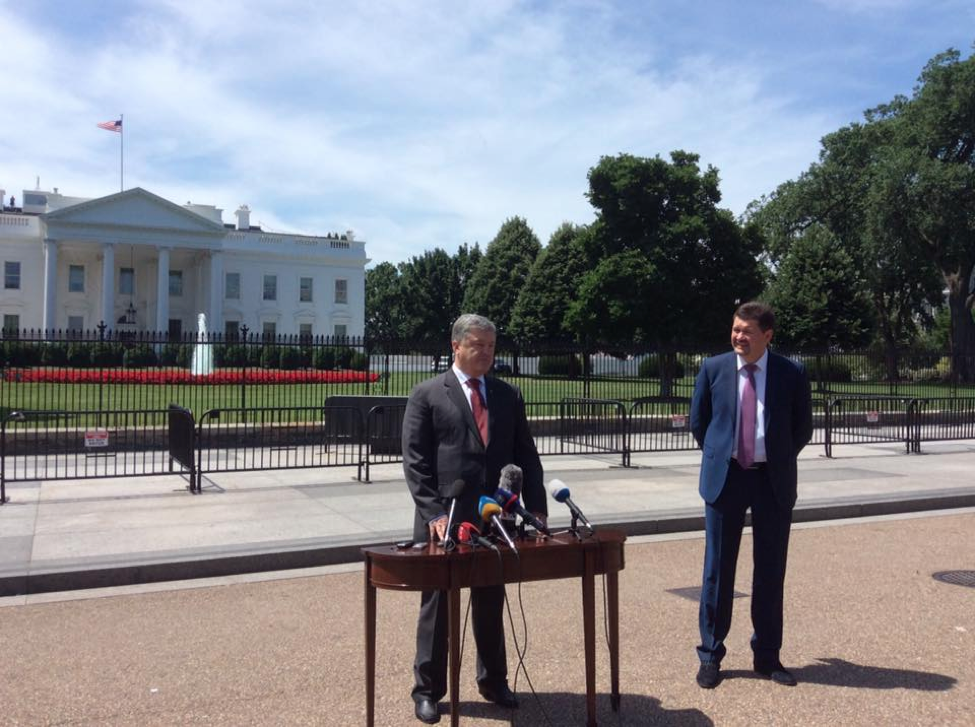
Poroshenko gives an apparently impromptu press conference on the street in front of the White House. Source: Facebook of Iryna Gerashchenko.
Further Meetings in Washington
In addition to the White House meetings, the Ukrainian delegation also met with Defense Secretary Jim Mattis and his senior staff. Poroshenko, receiving full honors, sang along to the Ukrainian National Anthem as it played. During their joint appearance, Poroshenko expressed his appreciation for the Pentagon’s support of Ukraine’s military and his hopes for further cooperation. He also highlighted that Ukraine spends 6% of its GDP on defense, while the U.S. has been trying to get its NATO allies to reach the 2% goal.
Secretary Mattis gave Poroshenko a picture of the two of them, the frame inscribed with the words, “From One Patriot to Another — With Respect.” Mattis, widely respected in the United States, said that Ukraine and the U.S. share a “commitment [to] the principles underlying the international order. Words like sovereignty, territorial integrity and freedom from coercion come to mind.” He praised Ukraine’s ability to defend itself “against all odds” and “in the face of dangers from aggression, cyber attacks, [and] a neighbor shredding trust.” On the issue of whether or not the United States will provide Ukraine with lethal defensive weapons, a Pentagon spokesperson said, “We don’t rule out the option of doing so in the future.” Regarding U.S. sanctions on Russia, the spokesperson said that they will “remain in place until Moscow reverses the actions that triggered [them].”
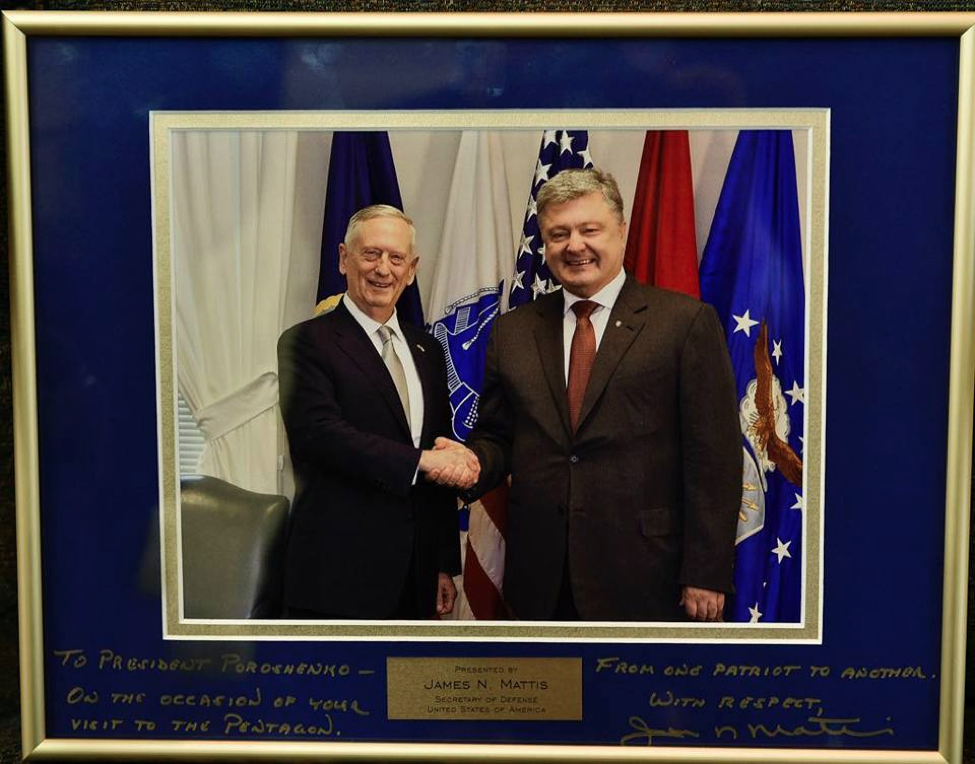
Source: Facebook of Svyatoslav Tsegolko
At the Department of State (the U.S. equivalent of a ministry of foreign affairs), Poroshenko and Secretary Rex Tillerson “coordinated positions as regards termination [sic] of Russian aggression in Donbas and return of Crimea [співрозмовники скоординували позиції щодо припинення російської агресії на Донбасі та повернення Криму],” according to a statement from Poroshenko’s administration. The statement added that “the U.S. Secretary of State also confirmed preservation of sanctions against Russia until full restoration of Ukraine’s sovereignty and territorial integrity [Держсекретар США підтвердив збереження санкцій проти Росії до повного відновлення суверенітету і територіальної цілісності України].”
Poroshenko and Secretary Tillerson’s joint appearance was brief and stilted. Each thanked the other for the meeting, then one journalist posed a general question about Russia to Tillerson, who responded only with “We’re in discussions.” That was the end of the joint appearance. In the past, however, the State Department has been fuller in its comments. Speaking in Belgium on March 31, Secretary Tillerson said that “Russia’s aggression against Ukraine shook the very foundations of security and stability in Europe. Today, Russia’s ongoing hostility and occupation is compromising our shared vision of a Europe that is whole, free, and at peace… The United States sanctions will remain until Moscow reverses the actions that triggered our sanctions.” And in the past, Department spokespersons have reiterated “that sanctions will remain in place until Russia returns control of the Crimean peninsula to Ukraine and fully implements its commitments in the Minsk agreements.”
The Ukrainian delegation also had meetings with the Secretary of Commerce, where the parties discussed developing bilateral trade; and the Secretary of Energy, with whom Poroshenko discussed cooperation on nuclear energy, hydrocarbons, renewables, and — very cleverly — the U.S. coal exports to Ukraine. Poroshenko’s meeting with Christine LaGarde, managing director of the IMF, led Timothy Ash to suspect that the IMF might soften its position on pension reform, land reform, and other structural changes that need to be made before the IMF releases the next tranche to Ukraine.
One of the most important meetings for Poroshenko, however, was with Paul Ryan, the Speaker of the House of Representatives. Following the meeting, Ryan issued a statement saying it was a “privilege” to welcome Poroshenko and that Congressional support for Ukraine transcends party lines because the U.S.-Ukrainian relationship “is critical to our national security and our shared values.” Ryan says that he and Poroshenko “discussed ways to build on this partnership and counter threats posed to both of our nations by Russia.” Speaker Ryan also said that he supports “additional sanctions,” which Iryna Gerashchenko interpreted to mean “the necessity of increasing sanctions against Russia until full implementation of the Minsk agreements, as well as restoration of sovereignty and territorial integrity of Ukraine, including Crimea.” It is more likely that Ryan was suggesting that the House would pass some additional sanctions against Russia for its interventions, and not that sanctions would be continuously increased until Ukraine’s grievances were all addressed.
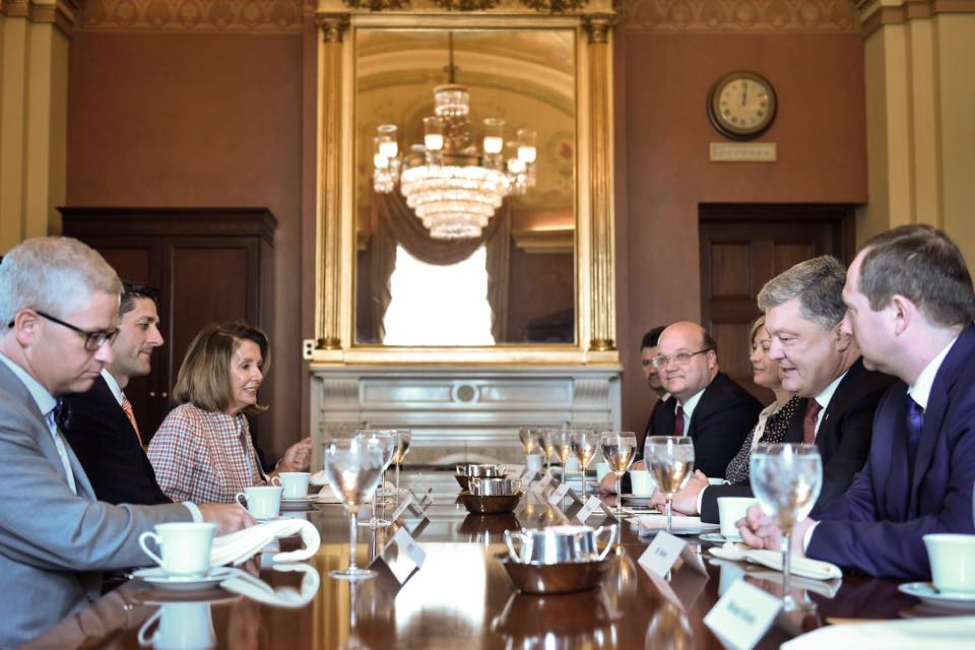
Poroshenko and his senior staff meet with Chief Deputy Whip Patrick McHenry, Speaker Paul Ryan, and Democratic Leader Nancy Pelosi (left to right).
Political Context in Washington
Poroshenko’s meeting with House leadership was particularly important because Congress is currently considering a sanctions bill against the Kremlin that passed the Senate 97 votes to 2. The bill would prevent the Administration from lifting sanctions levied against Russian entities if Congress disapproved. Ukraine strongly supports this legislation, even though some analysts point out that if the restrictions make it nearly impossible to lift sanctions, Russia would lose its primary incentive to dial back the Donbas War. Currently, the Administration is free to lift the sanctions for any reason, and on June 21 the Department of State announced once more that the sanctions “will remain in place until Russia fully honors its obligations under the Minsk Agreements.”
In fact, this is why some argue that Poroshenko was playing a secondary role in a larger, U.S. political drama. Most Presidential administrations are opposed to having their hands tied by legislation that codifies sanctions, and Trump’s is no exception. This would be consistent with Trump seeking to relieve Congressional pressure regarding Russia by meeting with Poroshenko and by instituting further sanctions, announced a few hours before the meeting. These sanctions are not particularly substantial, but instead are part of a series of moves that are likely designed to demonstrate to Congress that Trump is tough on Russia and that there is no need codify the Russia sanctions.
Russia remains a toxic theme for the Trump Administration. The Trump campaign is being investigated for possible collusion with Russia, which if true would likely bring down the Administration. In addition, it is likely that Trump is under investigation for obstructing that investigation by firing FBI Director Comey. The Administration has said that although the Trump Administration seeks better relations with Russia, progress in that direction is impeded by the Kremlin’s actions in Ukraine. Ukraine, therefore, provides a useful opportunity for Trump to demonstrate his toughness on Russia.
In fact, Tillerson is leading a behind-the-scenes effort to get the United States more involved in the Donbas War negotiations. He is expected the appoint a special envoy who will communicate directly with Vladislav Surkov, a top aide to President Putin. German Chancellor Angela Merkel told reporters in March that she supports opening such a communications channel. One Western diplomat told Buzzfeed, “If you want to pressure the Russians, you need the Americans on board.”
All in all, Ukraine’s delegation appeared to be playing the role of a piece in this game. Trump does not want to be restricted by the sanctions bill being considered by the House, so he is attempting to demonstrate his engagement on Ukraine by getting serious on Russia. By meeting with Poroshenko, slightly increasing sanctions, and exploring an increased role in the Donbas-related negotiations, the Trump Administration is trying to keep doors open for its cooperation with Russia. If Trump wanted to silence his critics, he would provide Ukraine with lethal weapons; by relieving some pressure, this move might allow him to proceed on issues against Ukraine’s interest. It does not appear that Ukrainian officials take this into account.
* * *
In the end, Poroshenko’s trip to Washington was successful because he was able to reassure himself and his country of American support. Ukraine and the United States will likely nominally increase their economic and defense-sector cooperation, and some U.S. cabinet secretaries are likely to visit Ukraine in the coming months. Moreover, the Ukrainians — and Congress — were repeatedly assured that the Trump Administration has no interest in lifting the Russia sanctions until the Kremlin complies with its Minsk II obligations. As Svitlana Zalishchuk wrote, it may be possible that this “hybrid visit will bring the end of the hybrid war that much closer [гібридний візит зміг наблизити гібридну війну до її завершення].”
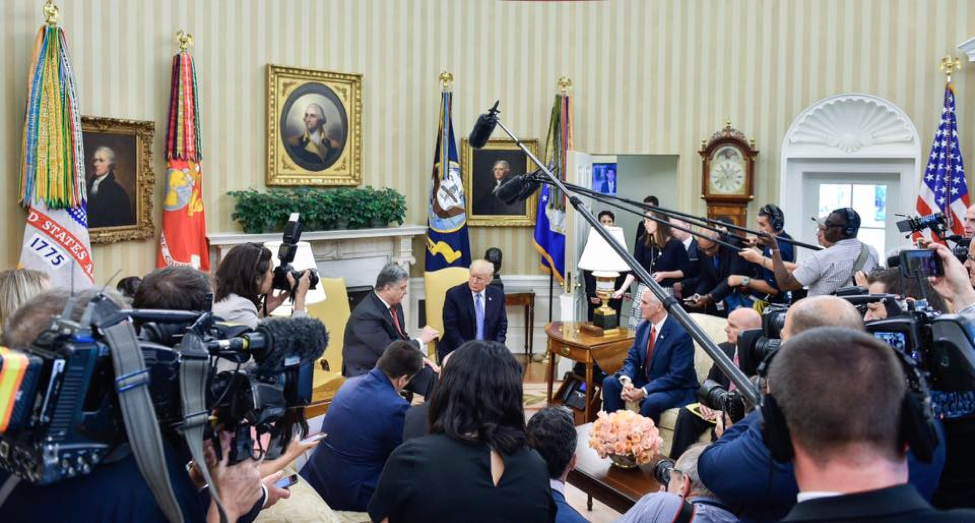
Media surrounding Poroshenko and Trump. Source: Facebook of Iryna Gerashchenko.
Attention
The author doesn`t work for, consult to, own shares in or receive funding from any company or organization that would benefit from this article, and have no relevant affiliations



